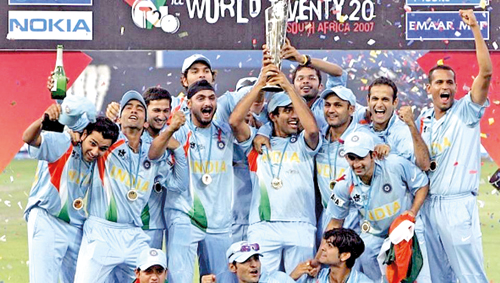Undercurrents behind the understrength India at Nidahas
View(s):
In 2007 India won the ICC T-20 world cup playing with a bunch of youngsters under Dohni and India was never the same cricket unit ever again.
May be, a half-a-century ago, the rest of the cricketing folk made it a fashion to indulge in light banter with regard to Indian cricket. They were of the view that the Indians had the knack of losing matches – managing to pull off a defeat from the jaws of victory, they used to smirk.
I am sure it hurt the pride of the Indians, but they waited patiently till the worm turned. The Indians may have lost matches along the way in international cricket but, for the mundane Indian cricketer, the game was only next to religion and more of a unifying factor. Thus, as the years passed, the game of cricket also became a believing factor to the billion plus nation, and the Indian cricket coffers began to grow through technology – TV and the related franchises.
In the midst, cricketers of the calibre of Nawab of Padaudi, Bhagwat Chandrasekar, Bishen Singh Bedi, Sunil Gavaskar, Kapil Dev and Sachin Tendulkar helped the Indians invent their own folklore and the brilliance of those individuals. When Mahendra Singh Dhoni led a bunch of second stringers to beat arch rivals Pakistan in the final in South Africa and win the inaugural 2007 ICC T-20 championships, a feat that led to the establishment of the Indian Premier League T-20 tournament, a new culture was born.
India became the centre of World Cricket. From Brian Lara to Akila Dhananjaya, they wanted a piece of the pie, while India handed out the dollars and in return usurped their expertise.
From that point, the rise of Indian cricket has been meteoric. Now, at the moment, they have begun replying to the hecklers of yore. I think they are on a crusade to conquer bat and make a new cricketing order, with India at the helm.
The Indians believe in setting up the rule from the junior stage. A few days ago, while exchanging views on cricket, about the under performance of our under (U)-19 team at the age group ICC World Cup, national chief selector Graeme Labrooy came up with a very significant argument.
He was of the view that India’s approach to the preparations is quite different to Sri Lanka’s, in spite of Sri Lanka also being a top cricket playing nation. He was explaining that Indian junior cricket has a very different approach. Yes, like some other top Test playing nations, the Indians also begin their preparations over one-and-a-half years to the event. (Yet, according to the chief selector, the Lankans do not seem to do this.) Yet, from that point onwards, the preparations differ.
During that chat, Labrooy pointed out that, when the Indian U-19 team went to Malaysia, to take part in the Asia Cup U-19 tournament, that was not their primary objective. For them, even the Asia Cup was a part of the preparations for the ‘big one’ to be played in New Zealand.
Their preparations included encouraging U-19 players to play in the first class tournament like the Ranji Trophy and also, there are provisions for U-19 players in the IPL. Yet for all, an Indian U-19 cricketer can play in the World Cup only once and, by that time, the player is expected to move on to the bigger field of activity. The training regime is tough and challenging.
The preceding thoughts came to my mind while watching the first ‘Nidahas’ Trophy triangular match between Sri Lanka and India.
Nevertheless, one could not ask for a better background for Chandika Hathurusinghe and his team, because the situation was just down their street of comfort. The first outing was tailor-made for them and, to add to that, Dinesh Chandimal won the toss and put the visitors into bat. Finally, it resulted in the Lankans playing a well calculated game and drawing first blood.
Jubilation apart, I was just pondering the modus operandi of the Indians. It is a high volume triangular involving the three biggest neighbouring countries you could put together – India, Bangladesh and Sri Lanka. Automatically, it ought to be a money spinner where the TV audience is concerned. Yet, the Indians opted to go with a bunch of third string hopefuls who may not have the wherewithal to take home the ‘Nidahas Trophy’. Now it seems that the matches are not even aired to the Indian TV audience.
Just imagine the top line names that are missing in the melting pot. The lineup begins with the name of the Indian skipper Virat Kohli. The rest of the names include M.S. Dhoni, Jasprit Bumrah, Buvanesh Kumar, Ravichandran Ashwin, Cheteshwar Pujara, Kuldeep Yadav, Ishant Sharma, Ajinkya Rahane, Murali Vijay, Umesh Yadav, Mohammad Shami, Shreyas Iyer, Ravindra Jadeja, Krunal Pandya, Wriddhiman Saha and Hardik Pandya. The list that I counted runs up to 17. That is why I am of the opinion that the Indians are carrying an underrated third string ensemble.
Definitely, the idea behind this is not India trying to belittle Sri Lanka as a nation. But, when one takes the bigger picture of Indian cricket, the story looks a bit ironic. First of all, they are not interested in risking their players before they play England and Australia and will also sweat it out during the gruelling IPL tournament right after this outing.
That is one side of the story. The other side is another juxtaposition of possibilities. Remember when the Indians lost their first two Test matches against South Africa recently, controversial Bishen Sing Bedi openly said it was because they did not get sufficient match exposure by playing low grade cricket against Sri Lanka. He claimed if they had trained on their own, they would have had better sparring partners in local second string cricketers.
 Yes, gradually the Indians are moving away from the sub-continent dream. They are trying their best to inculcate a habit of not playing against the bottom-ranked nations. Some feel that, playing against England, Australia and South Africa is more financially viable and invariably, the quality of cricket is also better.
Yes, gradually the Indians are moving away from the sub-continent dream. They are trying their best to inculcate a habit of not playing against the bottom-ranked nations. Some feel that, playing against England, Australia and South Africa is more financially viable and invariably, the quality of cricket is also better.
Last week we learned that the Indian cricket management had, had matched the Indian cricketers with salaries akin those of countries like England and Australia. They feel that Indian cricket belongs up there.
At the same time, playing against Sri Lanka, Bangladesh, Pakistan, West Indies and even New Zealand, will be a strain on Indian cricket coffers. They feel they do not have to play against any of those weak oppositions, nor do they need their vote, when it comes to a push at an ICC issue. Right now, Indian cricket is powerful enough to take the bull by its horns and drive in their opinion through their dollar power. The danger is, would this Nidahas trend continue into the future and create a split in the cricket order?


